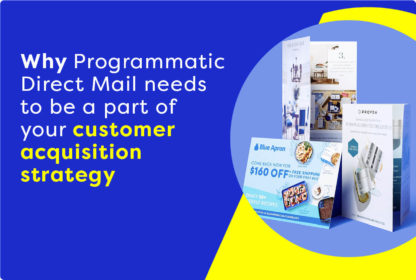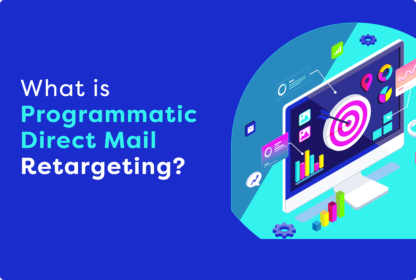With Programmatic Direct Mail it’s important to remember that while the final format of the message is the same as Traditional Direct Mail (a physical piece of mail), everything that goes into who sees that message is very different. Programmatic Direct Mail is all about identifying audiences of in-market consumers using machine learning and gobsmacking amounts of online and offline data. And of all the data that goes into defining these audiences, the most pivotal in terms of a program reaching its performance potential is a brand’s first-party data.
Customer data from your website, your CRM, and your transaction history is how these machines learn to separate intent signals from noisy static. It’s how they come to understand what drives performance for your brand and what makes your best customers the best. These kinds of data-driven strategies, if implemented correctly, can propel performance throughout the entire customer lifecycle.
Let’s explore the four audience types built around your first-party data that can be your secret weapon to driving profitable growth.
1. “Lookalike” Audiences: Finding Your Next Best Customers
Modeling “lookalike” audiences is like first-party data magic. You start with your existing customer base, gather data on their demographics, behaviors, and preferences, and then voilà – you have a blueprint to find similar potential customers who are likely to convert.
These modeled audiences allow you to expand beyond your current customer base while maintaining a high level of relevance. Platforms like Facebook and Google Ads popularized this tactic, making it a staple for any customer acquisition program. Now you can implement this powerful strategy outside the confines of digital environments with Programmatic Direct Mail.
When doing so, however, you want to make sure your PDM solutions partner is factoring in real-time behavioral data, like digital browsing and buying activity and engagement with the PDM channel, as well as demographic data when modeling these audiences. That way you know your ad spend is targeted toward individuals who not only share characteristics with your most valuable customers, but are actively in-market and receptive to the format and channel.
2. Retargeting Prospects: Nurturing the Almost-Converted
Only 1.81% to 3.71% of e-commerce website visits actually end in a purchase. So of the remaining 94%, how do you separate the visitors with real, active purchase intent from the looky-loos? Well, retargeting is your answer.
This audience type is all about rekindling the interest of individuals who have already shown some intent to engage with your brand via your website. With Programmatic Direct Mail retargeting, audiences can be created one of two ways:
- Rules-based with triggers: An automated strategy where you create a “trigger” that sends a piece of mail (similar to an email marketing automation) based on whether or not someone has taken an action on your website.
- Intent-based with machine learning: A machine-learning driven strategy that takes large scale data about all website visitors and uses it to create addressable audiences based on their conversion potential.
It’s important to note that while intent-based audiences tend to perform better, you need a large amount of first-party website data in order to create enough signal to achieve statistical significance. So for smaller brands, a rules-based approach may be more economical and impactful.
In both instances, dynamic workflows and automation allow for consumers with the highest levels of active purchase intent to be matched to a postal address and mailed within 24 hours of their visit.
This combination of speed and relevance makes this a highly effective tactic for reminding potential customers of their interest, gently nudging them to come back and make a purchase. It often leads to higher conversion rates and a boost in revenue.
3. Retargeting Customers: Keeping the Flame Alive
Your existing customers are an invaluable asset, and it’s essential to maintain a strong relationship with them. Retargeting your customers can help you keep the flame alive, whether it’s turning one-time buyers into brand advocates or rewarding long-time loyalists with special offers.
When focusing on existing customers, Programmatic Direct Mail retargeting audiences work a little differently than when targeting prospects. In these cases, you pre-define the audience (i.e., “Big Spenders,” “Loyalty Card Members,” etc.), so that the PDM partner can dynamically identify the customer, match the creative, and mail the next day. This ensures a personalized marketing message reaches your best customers while your brand is still top-of-mind.
Use customer retargeting to upsell or cross-sell complementary products, announce exclusive offers, or simply remind them of your brand’s presence. By nurturing this audience segment, you can increase customer lifetime value and promote loyalty while fostering cost-effective growth.
4. CRM Segment Engagement: Personalizing the Journey
Your CRM (Customer Relationship Management) system holds a treasure trove of data about your customers. Segmenting this data and tailoring your marketing efforts to specific groups can significantly impact your performance. By engaging with a target CRM segment, you can deliver highly personalized content and experiences.
For example, if you have a group of customers who frequently purchase a particular product category, send them customized recommendations or early access to new products in that category. Tailored experiences like these can enhance customer satisfaction, increase retention rates, and drive higher revenue.
Or, if you have a segment of lapsed customers, you can use a seed list of your best customers (much like you would with a lookalike audience) to identify who has the greatest likelihood of coming back so you can power more efficient performance while winning back what was previously lost revenue.
In Conclusion
As you navigate the complex landscape of modern marketing and explore the possibilities of PDM, remember that not all audiences are created equal. By strategically leveraging your first-party data to create lookalike audiences, retarget both prospects and customers, optimize your existing customer file, and engage target CRM segments, you can supercharge your brand’s performance throughout the customer lifecycle.
These audience types are not mutually exclusive; in fact, they work best when used in harmony. The key is to continuously analyze data, refine your targeting strategies, and adapt to changing customer behaviors. As you do, you’ll find that these audiences are not just tools but the secret sauce that transforms your brand into a customer-centric powerhouse. So, go ahead, start harnessing the power of different audiences, and watch your brand soar to new heights!


